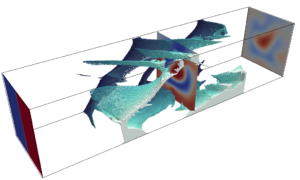Topology Optimization of Static Mixers
Description of the Problem
Static mixers, a part of a pipe in which the incoming fluid streams are mixed by the internal pipe geometry while decreasing pressure as little as possible, have been used since the 1970s for blending fluids in applications ranging from waste-water treatment, to food processing, to pharmaceutical and chemical applications. Since static mixers are passive devices without any moving parts, they are reliable, low maintenance, and inexpensive to produce.
However, optimizing static mixers demands understanding the multiscale nature of turbulence : macromixing of the large convective scales of the mean flow, mesomixing at smaller inertial scales, and micromixing at the diffusive scales.


Scientific Relevance and Impact
Our work on this Lighthouse Case is the first demonstration of topology optimization of turbulent static mixers in complex flow situations. It will advance the current state of the art on various levels:
- algorithmically for large-scale optimisation,
- mathematically for developing ways to treat a chaotic system,
- computationally to perform large-scale 3D optimisation.
Codes Used
Neko
